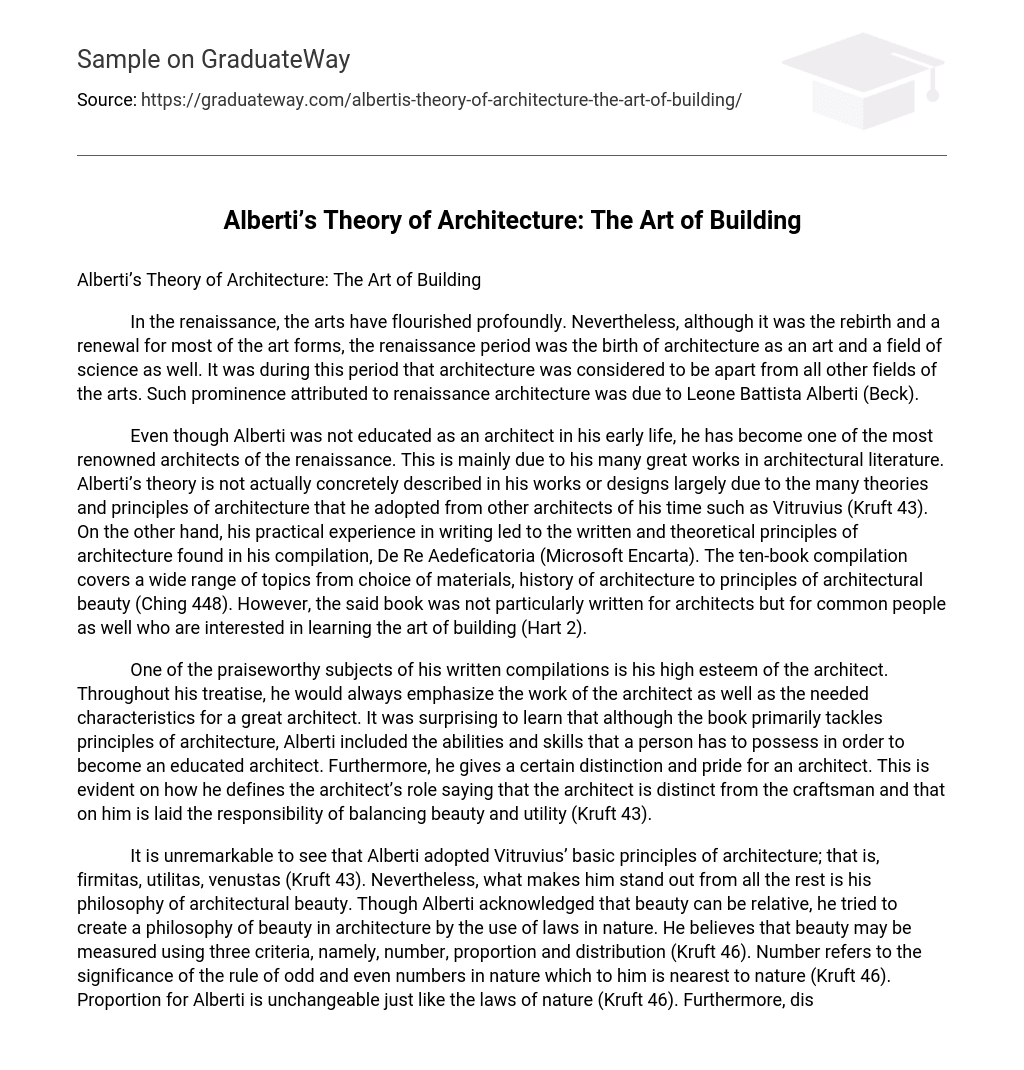In the renaissance, the arts have flourished profoundly. Nevertheless, although it was the rebirth and a renewal for most of the art forms, the renaissance period was the birth of architecture as an art and a field of science as well. It was during this period that architecture was considered to be apart from all other fields of the arts. Such prominence attributed to renaissance architecture was due to Leone Battista Alberti (Beck).
Even though Alberti was not educated as an architect in his early life, he has become one of the most renowned architects of the renaissance. This is mainly due to his many great works in architectural literature. Alberti’s theory is not actually concretely described in his works or designs largely due to the many theories and principles of architecture that he adopted from other architects of his time such as Vitruvius (Kruft 43). On the other hand, his practical experience in writing led to the written and theoretical principles of architecture found in his compilation, De Re Aedeficatoria (Microsoft Encarta). The ten-book compilation covers a wide range of topics from choice of materials, history of architecture to principles of architectural beauty (Ching 448). However, the said book was not particularly written for architects but for common people as well who are interested in learning the art of building (Hart 2).
One of the praiseworthy subjects of his written compilations is his high esteem of the architect. Throughout his treatise, he would always emphasize the work of the architect as well as the needed characteristics for a great architect. It was surprising to learn that although the book primarily tackles principles of architecture, Alberti included the abilities and skills that a person has to possess in order to become an educated architect. Furthermore, he gives a certain distinction and pride for an architect. This is evident on how he defines the architect’s role saying that the architect is distinct from the craftsman and that on him is laid the responsibility of balancing beauty and utility (Kruft 43).
It is unremarkable to see that Alberti adopted Vitruvius’ basic principles of architecture; that is, firmitas, utilitas, venustas (Kruft 43). Nevertheless, what makes him stand out from all the rest is his philosophy of architectural beauty. Though Alberti acknowledged that beauty can be relative, he tried to create a philosophy of beauty in architecture by the use of laws in nature. He believes that beauty may be measured using three criteria, namely, number, proportion and distribution (Kruft 46). Number refers to the significance of the rule of odd and even numbers in nature which to him is nearest to nature (Kruft 46). Proportion for Alberti is unchangeable just like the laws of nature (Kruft 46). Furthermore, distribution concerns symmetry in architectural design where the position of parts of the building should be relative to one another (Kruft 47). Again, this idea is derived from the laws of nature. Thus, it is quite obvious that Alberti tries to define beauty as that which is in harmony with nature. Another noteworthy concept of Alberti’s theory is that he presumes laws of nature are also laws of architecture and thus, should be obeyed by the architect. Such thinking must be due to his training and education in canon law, therefore creating a philosophy that architecture is governed by laws.
Alberti’s treatise has a broad range of subjects and concepts. Whereas many of his architectural designs were based on his treatise, many architects consider his concepts as mere theoretical principles. Nonetheless, the fact that he can implement them on buildings he designed means that such theories were actually applicable in the field of architecture. Alberti’s theories are not just theories of architecture but are also a significant contribution to architectural literature.
Works Cited
Beck, James H. Renaissance Art and Architecture. Microsoft® Encarta® 2007 [CD]. Redmond, WA: Microsoft Corporation, 2006.
Ching, Francis D.K., Mark M. Jarzombek, and Vikramaditya Prakash. A Global History of Architecture. John Wiley & Sons, Inc., 2006.
Hart, Vaughan, and Peter Hicks, eds. Paper Palaces, The Rise of the Renaissance Architectural Treatise. London: Yale University Press, 1998. 1-16.
Kruft, Hanno-Walter. A History of Architectural Theory from Vitruvius to the Present. Tr. Taylor, Ronald, Elsie Callander, and Antony Wood. New York: Princeton Architectural Press, 1994. 41-50.
Leon Battista Alberti. Microsoft® Encarta® 2007 [CD]. Redmond, WA: Microsoft Corporation, 2006.





